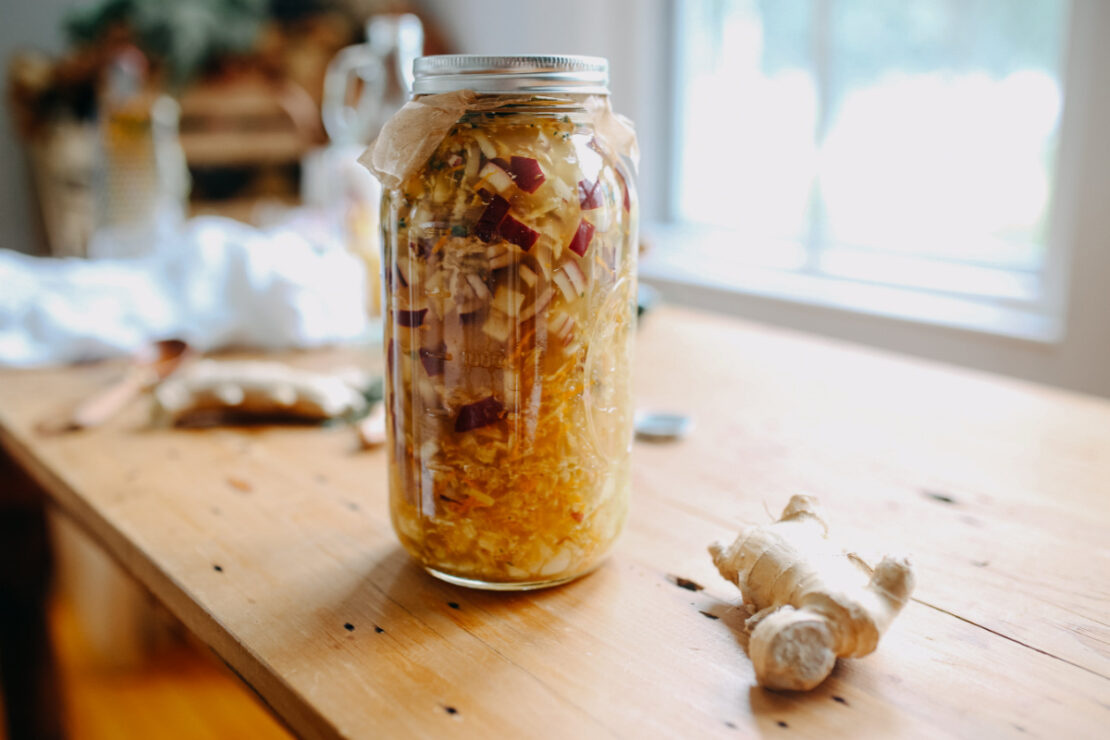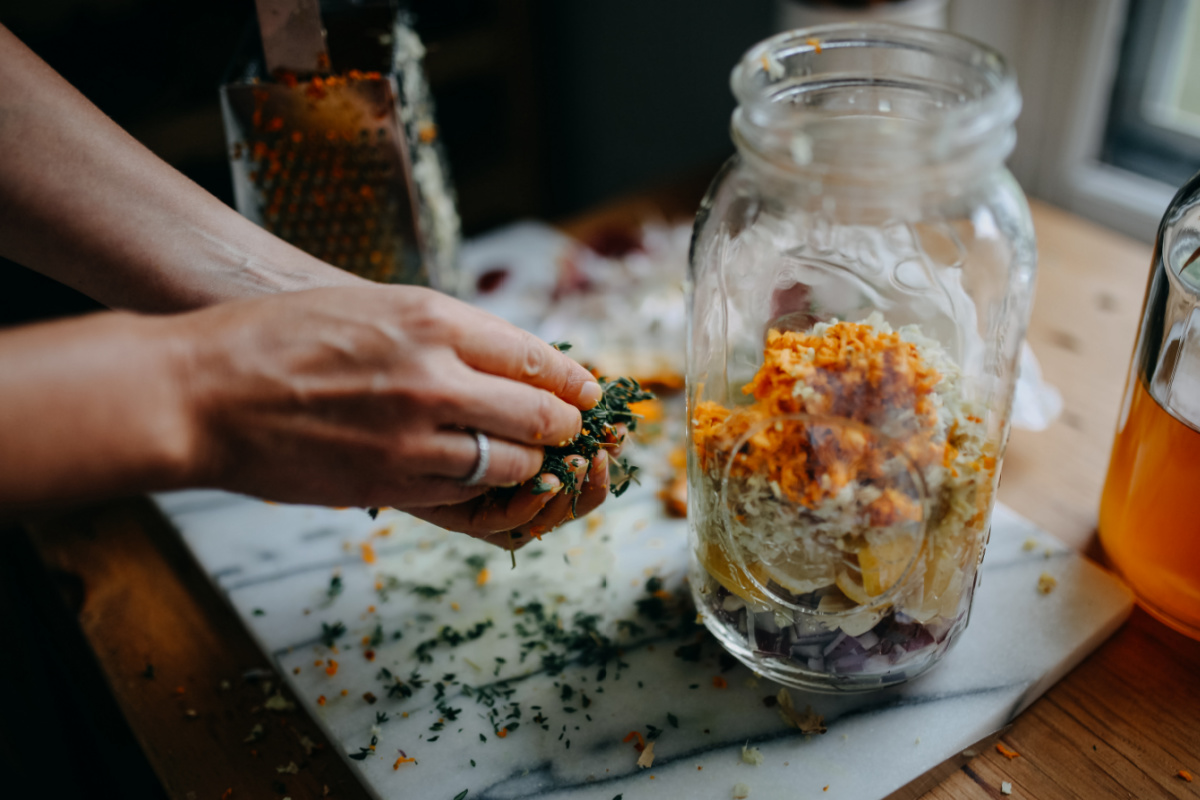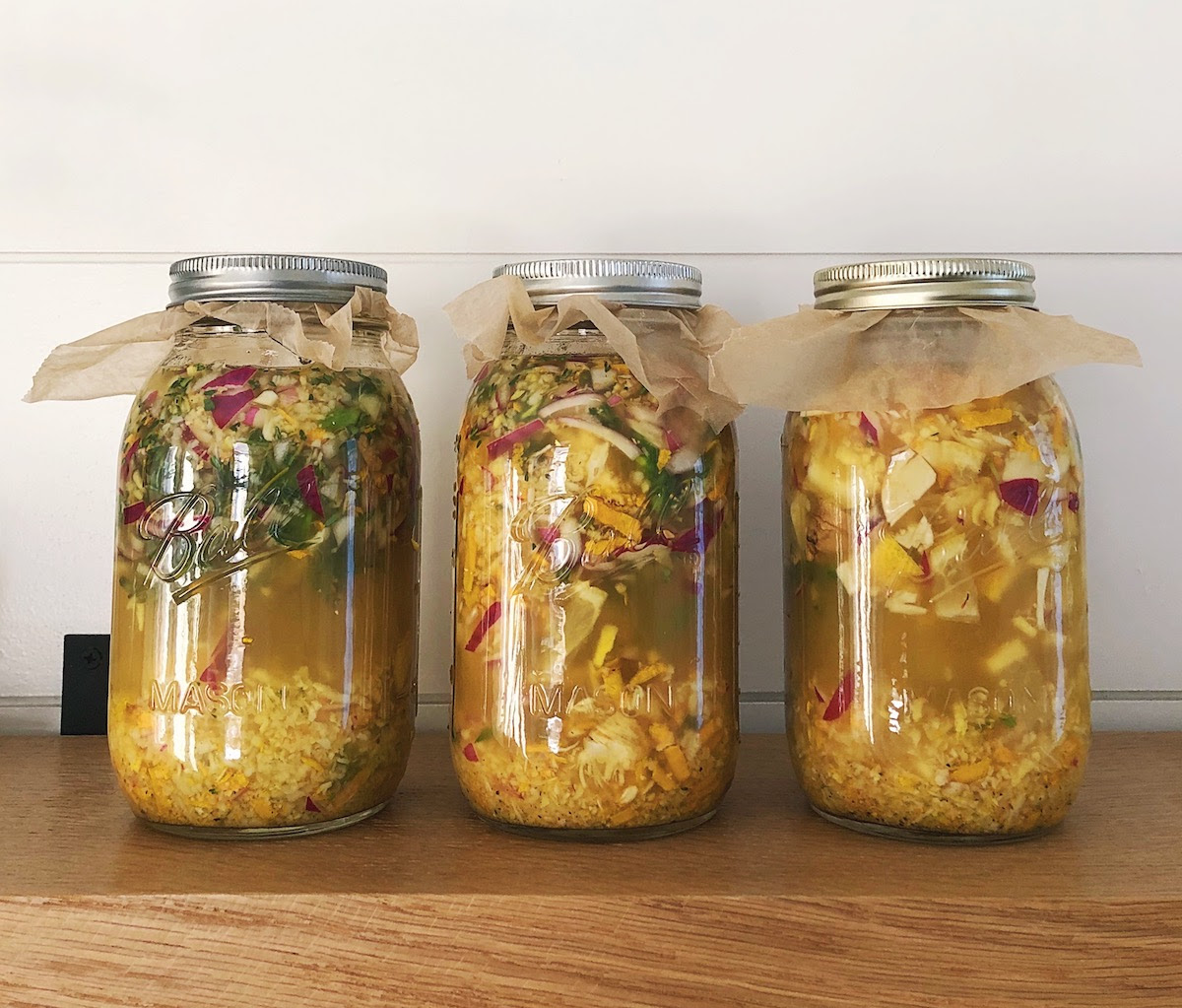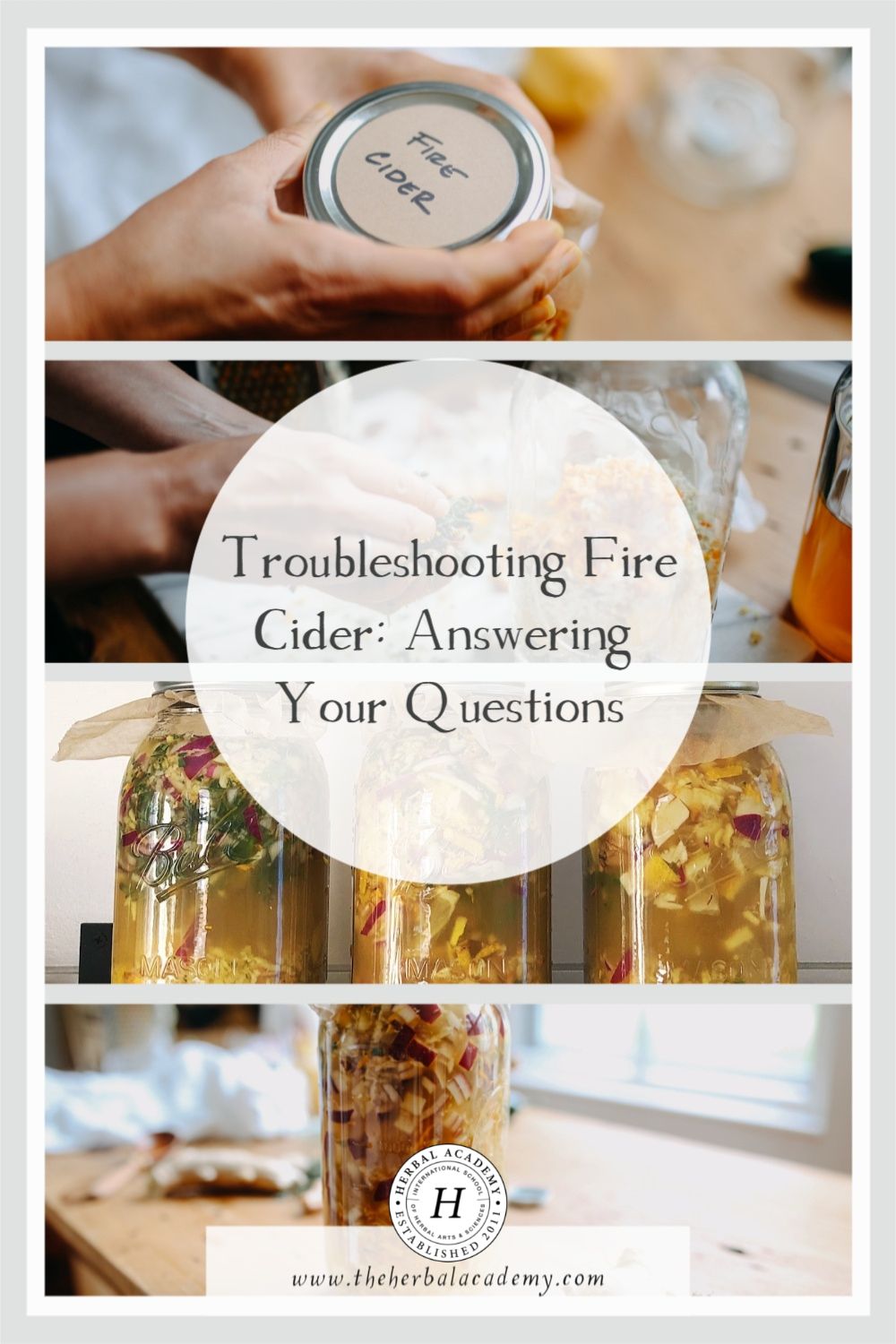
Troubleshooting Fire Cider: Answering Your Questions
Fire cider is a beloved and potent wellness tonic known for giving the immune system a powerful kick. Made from a variety of herbs infused into apple cider vinegar, a classic herbalist’s recipe is easy to make, convenient to dose, and a delight to the tastebuds.
Here at the Herbal Academy, we’ve been sharing our base recipe for years. You can find it on our blog post “How to Make Homemade Fire Cider” and featured in our free Herbal Support for Cold and Flu Ebook. Over the years of sharing, we’ve also received a good deal of questions from our community about this popular preparation—so many that we’ve decided to build a comprehensive guide for troubleshooting fire cider!
Do you have questions about how to make, use, or store this zesty preparation? Refer to our troubleshooting Q&A below to answer your questions.

Fire Cider Troubleshooting Q&A
Do you use fire cider for prevention or when you get sick?
Both! Some enjoy taking it as a daily tonic for overall wellness, especially during the fall and winter seasons. It can also be taken several times daily (see dosage information below) for acute immune support when faced with seasonal or environmental challenges.
Fire cider is best for cold and damp tissue states. Because some people find it to be drying, it is not ideal for a throat irritated by dry cough.
Can I omit honey from fire cider?
You can absolutely omit honey from fire cider. It will be quite spicy though! Because honey helps extend the shelf life, use your fire cider within 3 months if choosing to omit honey.
What is the shelf life of fire cider?
The Herbal Academy’s fire cider recipe uses fresh herbs, so we recommend refrigerating the final preparation and using it within 6 months.
If you are using dried herbs, your fire cider can be stored in a cool, dark pantry for up to 1 year. However, if you have the space, refrigeration will keep it fresher for longer.
Do I need to put fire cider in the refrigerator?
You will extend the shelf life of your fire cider by refrigerating it. While it may keep for a couple of months in a cool pantry, refrigerating it will extend its shelf life to 6 months or longer.
I want to make fire cider, but where do I find horseradish?
You can often find horseradish in health food grocery stores such as Whole Foods, or at your local health food store or co-op. Speak with a produce manager at your store to see if they plan to stock this root seasonally, as some groceries do. If you cannot find horseradish root fresh, you might have luck searching your local grocery store for jarred horseradish in the refrigerator section, in the pickles, kimchi, and sauerkraut section, or with foods from the Jewish tradition. You may also find horseradish in the fall and winter months at farmer’s markets, but that really depends on the vendors participating.
As an alternative, you can buy horseradish powder online (places like Mountain Rose Herbs carry it) or substitute another herb or spice (see our substitution suggestions below).

How do you use fire cider?
Some people enjoy taking a “shot” or a spoonful as a daily tonic. Sip on it or add it to lemonade, juice, or even mixed drinks. Or dilute it in hot water with a little extra honey. You can also use it as an ingredient in marinades, salad dressings, soups, stews, sautees, or greens. Place a bottle on your kitchen table to use as a condiment. Fire cider makes a zesty, power-packed alternative to hot sauce!
What is the dosage?
For an adult, take 1 tablespoon once a day as a tonic or up to 3 tablespoons daily during an active infection. Fire cider can be taken every 3-4 hours for acute immune support.
Can children take it?
Yes, children older than 12 months can take fire cider. Keep in mind that babies and infants less than 12 months should not have honey because of the potential for infant botulism.
A child’s dosage of fire cider depends on their weight. If a 150 lb adult takes 1-2 tablespoons daily, you can use your child’s weight to determine how much they might take. A 30 lb child, for example, would take about ⅕ of that dose.
If fire cider is a little on the spicy side for a child, you can dilute it with a little water or juice.
Can people who are pregnant or breastfeeding take it?
Taking fire cider while pregnant or breastfeeding is up for debate. Some say that it depends if the apple cider vinegar is pasteurized or not. There are no known studies in this regard as is the case with most herbs and pregnancy.
In summary, the safety of taking fire cider during pregnancy has not been conclusively established. Although many choose to use it while pregnant, it is best to consult your midwife or trusted medical professional before use.
The garlic in my fire cider turned blue, green, etc… Is it bad?
It may feel alarming if you notice your fire cider turning rainbow colors like green and blue. Rest assured, this is totally normal! What you are noticing is an enzymatic reaction between compounds in the garlic and acid in the vinegar.

Ingredient Substitutes
One question our Herbal Academy team gets a lot is: “I don’t have all the ingredients to make the recipe, can I substitute ingredients?”
In short, yes, you can absolutely substitute ingredients in our base Herbalist Fire Cider recipe. We detailed this recipe in our Herbal Support for Cold and Flu Ebook and this blog post. There are many ways to make fire cider—and we also encourage experimenting with substitutes! Let’s dive in.
Substitute for horseradish:
There are so many recipes for fire cider out there and they certainly don’t need to have horseradish. Some horseradish-like options include wasabi or mustard seeds or nasturtium pods (just use a smaller amount than horseradish). Or, just leave out the horseradish.
Substitute for cayenne:
A variety of different peppers can be substituted for cayenne. What pepper you choose really depends on your personal preference for spice level and flavor profile. Some people prefer the hottest of the hot—like the Carolina reaper (Capsicum chinense), which won the Guinness World Record for spiciest pepper. And some prefer a more mild pepper like serrano (Capsicum annuum).
Substitute for honey:
While you can omit honey entirely, if you wish to add the sweetness back in, you can experiment with a number of different alternative sweeteners, such as liquid stevia (Stevia rebaudiana) leaf, monk (Siraitia grosvenorii) fruit, maple syrup, or erythritol. Note that erythritol can cause some people serious digestive upset, so use it with caution.
Substitute dry herbs for fresh ingredients:
If accessibility is making it hard for you to gather all your ingredients, you can also substitute dried ingredients. Keep in mind that you will use ⅓ to 1/2 as much of each herb from the base recipe if dried. For example, if the recipe called for 1 cup fresh turmeric (Curcuma longa) rhizome, you could use 1/3-1/2 cup dried turmeric. One benefit of using dried ingredients is a longer shelf life, as no water is introduced into the vinegar so the acidity isn’t diluted.

Fire Cider is One Staple in the Herbal Apothecary
Prepared and stored properly, this preparation is a staple of the herbalist’s kitchen and a dependable wellness defense tonic for the whole family. We hope our troubleshooting Q&A satiated your curiosity about all things fire cider. It’s time to get into your herbal kitchen and get chopping!
Making fire cider at home is a common gateway into herbalism. If you’re interested in building upon your herbal apothecary with scrumptious, wellness-promoting herbal recipes and kindling your enthusiasm for a lifelong path of learning, we invite you to join tens of thousands of like-minded folk in the Introductory Herbal Course—the best beginner herbalism program to do just that!
Learn how to integrate herbs into your daily life and how to make herbal preparations and body care products for daily care and common ailments. The Introductory Herbal Course will teach you the properties of familiar herbs and spices (as well as those not yet familiar to you) and explore their wellness-supporting uses. The engaging lessons, beautiful presentation, and sound knowledge will delight the learner in you and instill an appreciation for the gifts herbalism has to offer, inspiring your future studies as well. Build upon your fire cider skills and learn all about the Introductory Herbal Course here!








